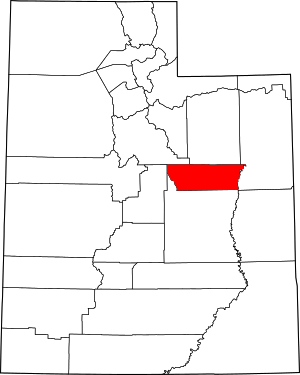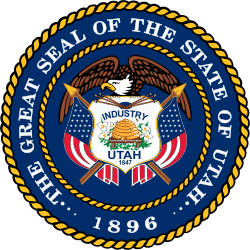Carbon County, Utah
Carbon County is a county in the U.S. state of Utah. As of the 2010 United States Census, the population was 21,403.[1] Its county seat and largest city is Price.[2]
Carbon County | |
|---|---|
 Carbon power plant at Castle Gate, Utah | |
 Location within the U.S. state of Utah | |
 Utah's location within the U.S. | |
| Coordinates: 39.64°N 110.58°W | |
| Country | |
| State | |
| Founded | March 8, 1894 |
| Named for | Abundant coal deposits |
| Seat | Price |
| Largest city | Price |
| Area | |
| • Total | 1,485 sq mi (3,850 km2) |
| • Land | 1,478 sq mi (3,830 km2) |
| • Water | 6.1 sq mi (16 km2) 0.4% |
| Population (2010) | |
| • Total | 21,403 |
| • Estimate (2019) | 20,463 |
| • Density | 13.8/sq mi (5.3/km2) |
| Time zone | UTC−7 (Mountain) |
| • Summer (DST) | UTC−6 (MDT) |
| Congressional district | 3rd |
| Website | www |
The Price, UT Micropolitan Statistical Area includes all of Carbon County.
History
Carbon County was part of Emery County which was founded in 1880. The demographics along the Price River changed with the construction of the Denver and Rio Grande Western Railroad in 1883 and the development of coal mines, largely in upper Emery, to fuel the railroad. The Utah Territory Legislature was partitioned to split off the north part, and thus it established Carbon County effective March 8, 1894.[3] It was named for the element Carbon, to emphasize the industrial nature of the area.[4]
Carbon County is the second largest natural gas producer in Utah (after Uintah County), with 94 billion cubic feet produced in 2008.[5]
Geography
The Green River flows south-southeastward along the county's east border. The lower central part of Carbon County is a continuation of Castle Valley in Emery County, but in Carbon the valley is ringed with mountains - the Wasatch Range to the west and northwest, and the Book Cliffs to the north and northeast.[6] The county generally slopes to the south and east; its highest point is Monument Peak on the crest of the Wasatch Mountains near the midpoint of the county's western border,[6] at 10,452' (3186m) ASL.[7] The county has a total area of 1,485 square miles (3,850 km2), of which 1,478 square miles (3,830 km2) is land and 6.1 square miles (16 km2) (0.4%) is water.[8]
Airports
- Carbon County Regional Airport (PUC) - Price
Major highways
- US Interstate US-6/US-191
- Utah State Highway 10
- Utah State Highway 96
- Utah State Highway 122
- Utah State Highway 123
- Utah State Highway 124
- Utah State Highway 139
- Utah State Highway 157[6]
Adjacent counties
- Utah County - northwest
- Duchesne County - north
- Uintah County - east
- Emery County - south
- Sanpete County - west
Protected areas
- Gordon Creek Wildlife Management Area[6]
- Manti National Forest (part)
- Price Canyon Recreation Area[6]
- Scofield State Park
Demographics
| Historical population | |||
|---|---|---|---|
| Census | Pop. | %± | |
| 1900 | 5,004 | — | |
| 1910 | 8,624 | 72.3% | |
| 1920 | 15,489 | 79.6% | |
| 1930 | 17,798 | 14.9% | |
| 1940 | 18,459 | 3.7% | |
| 1950 | 24,901 | 34.9% | |
| 1960 | 21,135 | −15.1% | |
| 1970 | 15,647 | −26.0% | |
| 1980 | 22,179 | 41.7% | |
| 1990 | 20,228 | −8.8% | |
| 2000 | 20,422 | 1.0% | |
| 2010 | 21,403 | 4.8% | |
| Est. 2019 | 20,463 | −4.4% | |
| US Decennial Census[9] 1790–1960[10] 1900–1990[11] 1990–2000[12] 2010–2018[1] 2019[13] | |||
2010 census
As of the 2010 United States Census, there were 21,403 people, 7,978 households, and 5,587 families in the county. The population density was 14.48/sqmi (5.59/km²). There were 9,551 housing units with an average density of 6.46/sqmi (2.50/km²). The racial makeup of the county was 92.31% White, 0.43% Black or African American, 1.18% Native American, 0.58% Asian, 0.01% Pacific Islander, 3.03% from other races, and 2.36% from two or more races. 12.42% of the population were Hispanic or Latino of any race.
There were 7,978 households, of which 30.16% had children under the age of 18 living with them. 54.50% were married couples living together, 10.65% had a female householder with no husband present, and 29.97% were non-families. 25.50% of all households were made up of individuals (one person), and 11.07% had someone living alone who was 65 years of age or older. The average household size was 2.61 and the average family size was 3.14.
The population contained 30.41% under the age of 20, 6.82% aged 20 to 24, 23.73% aged 25 to 44, 25.48% aged 45 to 64, and 13.56% who were 65 years of age or older. The median age was 34.4. For every 100 females, there were 98.40 males. For every 100 females age 18 and over, there were 96.88 males.
Politics
Carbon County historically has been the base of Democratic Party support in strongly Republican Utah with its sizable blue-collar population. It voted for Bill Clinton in 1992 and 1996 by wide margins. In 1964 Lyndon Johnson carried 72.7% of votes in the county. At the state level it was no less Democratic; in the 1992 gubernatorial election it was one of two counties (the other being Summit County) that voted for Democratic candidate Stewart Hanson over Republican Michael Leavitt.
After the turn of the millennium, however, Carbon County has trended Republican. It voted for George W. Bush in 2000 and 2004, while voting for the Democratic gubernatorial candidates. In 2008, John McCain won Carbon County with 52.60% of the vote, versus 44.59% for Barack Obama. In 2012, the county's Democratic vote fell further as Mitt Romney carried 67.3% to 30.1% for Obama. In 2016, despite Utah's strong swing against the Republicans due to the presence of conservative independent Evan McMullin, Carbon County was the only county in the state to swing more Republican, as Donald Trump won 66% to Hillary Clinton's 21.5% percent.
| Year | Republican | Democratic | Third parties |
|---|---|---|---|
| 2016 | 66.0% 5,275 | 21.5% 1,717 | 12.6% 1,007 |
| 2012 | 67.3% 5,090 | 30.1% 2,275 | 2.7% 202 |
| 2008 | 52.3% 4,091 | 44.3% 3,468 | 3.4% 263 |
| 2004 | 58.2% 4,950 | 40.1% 3,415 | 1.7% 143 |
| 2000 | 50.9% 3,758 | 44.7% 3,298 | 4.4% 328 |
| 1996 | 30.9% 2,343 | 55.0% 4,172 | 14.1% 1,067 |
| 1992 | 23.1% 2,038 | 50.8% 4,480 | 26.1% 2,299 |
| 1988 | 35.1% 3,019 | 64.2% 5,521 | 0.7% 63 |
| 1984 | 49.8% 4,393 | 49.4% 4,357 | 0.8% 68 |
| 1980 | 47.7% 4,320 | 47.6% 4,317 | 4.7% 426 |
| 1976 | 38.7% 3,360 | 59.4% 5,157 | 1.9% 166 |
| 1972 | 53.2% 3,956 | 44.8% 3,335 | 2.0% 147 |
| 1968 | 36.2% 2,618 | 60.0% 4,344 | 3.8% 277 |
| 1964 | 27.3% 2,130 | 72.7% 5,672 | |
| 1960 | 32.8% 2,953 | 67.1% 6,039 | 0.2% 14 |
| 1956 | 50.3% 4,507 | 49.7% 4,460 | |
| 1952 | 39.4% 3,770 | 60.6% 5,790 | |
| 1948 | 28.9% 2,704 | 68.3% 6,397 | 2.8% 259 |
| 1944 | 30.1% 2,318 | 69.7% 5,364 | 0.2% 14 |
| 1940 | 30.1% 2,242 | 69.5% 5,180 | 0.5% 34 |
| 1936 | 20.7% 1,348 | 77.4% 5,040 | 1.9% 122 |
| 1932 | 27.0% 1,655 | 69.3% 4,239 | 3.7% 226 |
| 1928 | 42.1% 2,184 | 56.9% 2,954 | 1.0% 50 |
| 1924 | 37.6% 1,878 | 30.6% 1,528 | 31.8% 1,590 |
| 1920 | 47.1% 1,675 | 43.8% 1,559 | 9.2% 326 |
| 1916 | 44.4% 1,301 | 50.4% 1,478 | 5.2% 152 |
| 1912 | 35.4% 771 | 23.6% 514 | 41.0% 892[16] |
| 1908 | 59.8% 1,023 | 34.0% 581 | 6.2% 106 |
| 1904 | 65.4% 1,224 | 27.1% 508 | 7.5% 140 |
| 1900 | 54.0% 748 | 44.8% 621 | 1.2% 16 |
| 1896 | 11.4% 85 | 88.6% 663 |
Cities
- East Carbon
- Helper
- Price (county seat)
- Wellington
Town
Census-designated places
Notable people
Carbon County has produced one governor of Utah, J. Bracken Lee (1899-1996; governor, 1949-1957). Lee also served as mayor of Price from 1935 to 1947, and later as mayor of Salt Lake City, from 1959 to 1971.
- Tom Apostol, Greek-American mathematician
References
- "State & County QuickFacts". United States Census Bureau. Archived from the original on July 8, 2011. Retrieved December 29, 2013.
- "Find a County". National Association of Counties. Archived from the original on May 31, 2011. Retrieved June 7, 2011.
- Individual County Chronologies/Carbon County UT. Newberry Library (accessed March 30, 2019)
- "Carbon County". I Love Utah History. Utah.gov. Retrieved February 10, 2017.
- "Annual natural gas production in MCF by the top 7 producing counties in Utah" (PDF). Archived from the original (PDF) on November 7, 2010. Retrieved September 12, 2010.
- Carbon County UT Google Maps (accessed 30 March 2019)
- "Utah County High Points/Carbon County. Peakbaggers (accessed 30 March 2019)". Archived from the original on March 27, 2019. Retrieved March 30, 2019.
- "2010 Census Gazetteer Files". US Census Bureau. August 22, 2012. Retrieved March 27, 2015.
- "US Decennial Census". US Census Bureau. Retrieved March 27, 2015.
- "Historical Census Browser". University of Virginia Library. Retrieved March 27, 2015.
- Forstall, Richard L., ed. (March 27, 1995). "Population of Counties by Decennial Census: 1900 to 1990". US Census Bureau. Retrieved March 27, 2015.
- "Census 2000 PHC-T-4. Ranking Tables for Counties: 1990 and 2000" (PDF). US Census Bureau. April 2, 2001. Retrieved March 27, 2015.
- "QuickFacts. Carbon County, Utah". Retrieved May 17, 2020.
- Bureau, US Census. "American FactFinder - Results". factfinder.census.govn. Archived from the original on February 13, 2020. Retrieved March 30, 2018.
- Leip, David. "Atlas of US Presidential Elections". uselectionatlas.org. Retrieved March 30, 2018.
- The leading "other" candidate, Progressive Theodore Roosevelt, received 541 votes, while Socialist candidate Eugene Debs received 344 votes, Socialist Labor candidate Arthur Reimer received 7 votes.
External links
| Wikimedia Commons has media related to Carbon County, Utah. |


